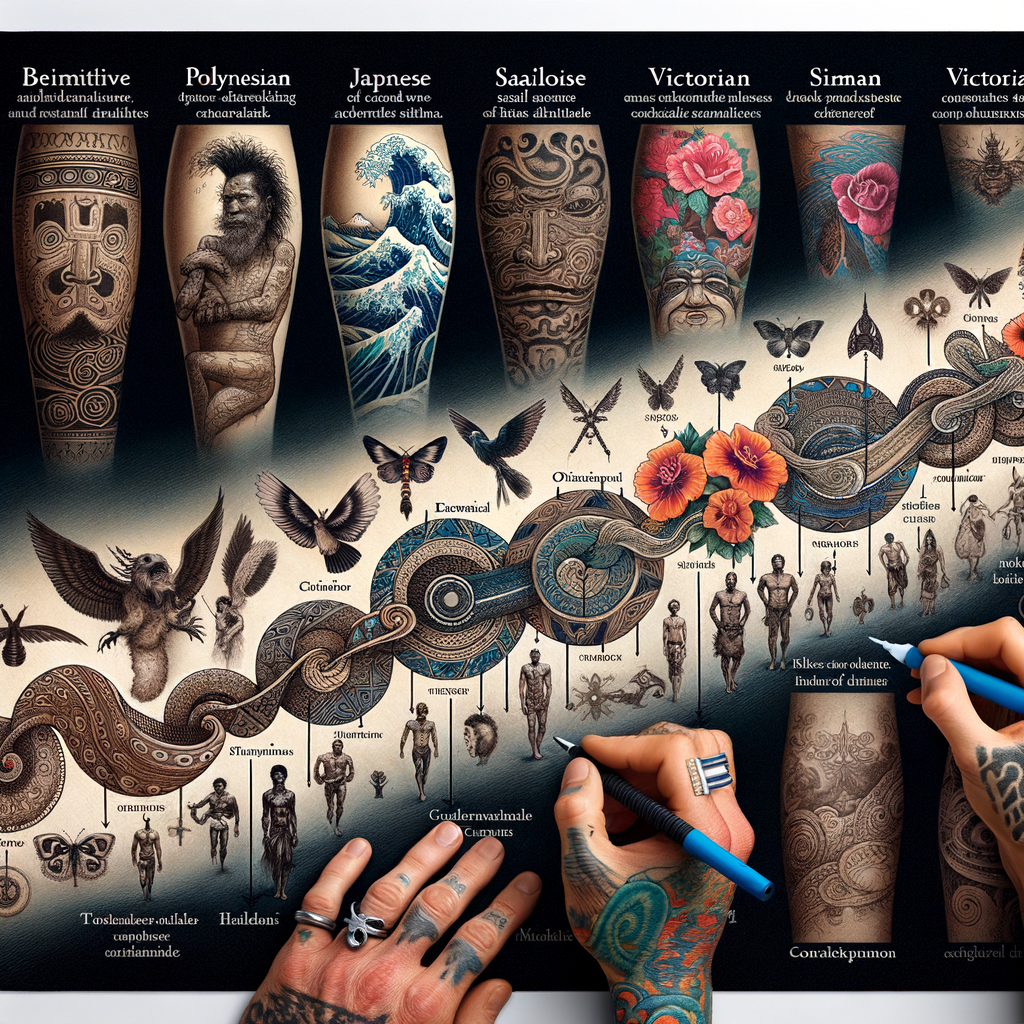
Ink Evolution: Tracing the Artistic Journey from Canvas to Skin
Art is a beautiful way of expressing oneself, and tattoos are no exception. Tattoos have evolved significantly over time, from being a symbol of rebellion to a widely accepted form of self-expression. Let’s delve into the fascinating journey of tattoo artistry, from canvas to skin.
- Introduction to Tattoo Artistry Evolution
- Understanding the Canvas to Skin Tattoo Journey
- Exploring the History of Tattoo Artistry
Tattoo artistry has come a long way. In ancient times, tattoos were used as a form of identification or to denote social status. Today, they are seen as a form of self-expression and art. The evolution of tattoo artistry is a fascinating journey that reflects the changing societal norms and attitudes towards body art.
Traditionally, artists used canvases to express their creativity. However, with the evolution of tattoo artistry, the human body has become the new canvas. This transition from canvas to skin was not an easy one. It required artists to adapt their techniques and tools to create art on a living, moving canvas. The process involves sketching the design on paper, transferring it onto the skin, and then using a tattoo machine to inject ink into the skin. This journey from canvas to skin is a testament to the skill and creativity of tattoo artists.
The history of tattoo artistry is as colorful as the tattoos themselves. The earliest evidence of tattoos dates back to ancient Egypt, where tattoos were used for religious and ceremonial purposes. Over time, tattoos have evolved in design, technique, and meaning. In the 20th century, tattoos became popular among sailors and soldiers. Today, tattoos are a popular form of self-expression, with millions of people worldwide sporting ink on their skin.
In conclusion, the evolution of tattoo artistry from canvas to skin is a fascinating journey. It reflects the changing societal norms and attitudes towards body art. Whether you’re a tattoo enthusiast or simply appreciate the art form, understanding the history and evolution of tattoo artistry can deepen your appreciation for this unique form of self-expression.
The Artistic Journey: From Canvas to Skin
Art has always been a form of expression, a way to tell stories, and a medium to represent cultures. One such form of art that has evolved over centuries is tattooing. Let’s explore the journey of tattoo art from traditional styles to modern designs.
Traditional Tattoo Art Styles
Traditional tattoo art styles have a rich history, each with unique characteristics and significance. They have evolved over time, adapting to cultural shifts and technological advancements.
- Origins and Evolution of Tattoo Designs
The art of tattooing dates back to ancient civilizations. The oldest known tattooed human skin to date is found on the body of Ötzi the Iceman, from between 3370 and 3100 BC. Traditional tattoo designs were often symbolic, representing social status, religious beliefs, or rites of passage.
Over the centuries, tattoo designs have evolved significantly. From the intricate tribal patterns of ancient Polynesia to the bold lines and vibrant colors of American traditional tattoos, each style reflects the culture and era it originated from.
- Traditional to Modern Tattoos: A Comparative Study
While traditional tattoos often carried deep cultural and symbolic meanings, modern tattoos are more diverse in their designs and motivations. Today, tattoos can be purely aesthetic, personal, or still carry traditional symbolism.
Traditional tattoo styles often used natural pigments and were applied manually, while modern tattoos use a variety of colors and are applied using electric tattoo machines. Despite these differences, both traditional and modern tattoos share a common purpose: to tell a story on the canvas of the skin.
Let’s compare these two eras of tattoo art in the table below:
| Aspect | Traditional Tattoos | Modern Tattoos |
|---|---|---|
| Designs | Symbolic, often linked to culture or religion | Diverse, ranging from symbolic to personal to aesthetic |
| Colors | Primarily black, using natural pigments | Wide range of colors, using synthetic inks |
| Application | Manually, often using bone or metal | Electric tattoo machines |
As we can see, the journey of tattoo art from canvas to skin is a fascinating one, filled with evolution and innovation. Whether traditional or modern, each tattoo tells a unique story, making this form of art as compelling as it is beautiful.
Modern Tattoo Techniques
As we journey from the canvas to the skin, it’s essential to understand the techniques that have revolutionized the tattoo industry. Modern tattoo techniques have brought a new dimension to this ancient art form, making it more precise, versatile, and expressive.
- Understanding Modern Tattoo Techniques
- Case Study: The Evolution of Tattoo Artistry Techniques
Modern tattoo techniques have evolved significantly from traditional methods. Today’s tattoo artists use advanced equipment like rotary and coil tattoo machines, which offer greater precision and control. This allows for more detailed and intricate designs, pushing the boundaries of what’s possible in tattoo artistry.
One of the most popular modern techniques is ‘shading’. This involves using different shades of ink to create a three-dimensional effect, giving the tattoo a sense of depth and realism. Another technique is ‘color packing’, where the artist packs the skin with a solid color to create vibrant, eye-catching designs.
These techniques require a high level of skill and experience. Aspiring tattoo artists often spend years honing their craft before they can master these techniques.
Let’s take a look at how tattoo techniques have evolved over the years. In the early days of tattooing, artists used hand-poking methods, where they would manually insert the ink into the skin using a needle. This was a time-consuming process and limited the complexity of the designs.
With the invention of the tattoo machine in the late 19th century, artists were able to create more detailed and intricate designs. This marked a significant turning point in the evolution of tattoo artistry.
In the 21st century, the introduction of digital technology has further revolutionized tattoo techniques. Artists now use digital design software to create their designs, allowing for unprecedented precision and detail. They can also use laser technology for tattoo removal, giving people the freedom to change or remove their tattoos.
This evolution of techniques has expanded the possibilities of what can be achieved in tattoo artistry, making it a truly modern art form.
Tattoo Culture Evolution
As we delve into the fascinating world of tattoos, it’s essential to understand how culture has shaped this art form. The evolution of tattoo culture is a testament to the influence of various cultures on this unique form of self-expression.
Impact of Culture on Tattoo Artistry
Culture plays a significant role in shaping the art of tattooing. Let’s explore how culture influences tattoo designs and examine a case study that highlights this progression.
- How Culture Influences Tattoo Designs
- Case Study: Cultural Influence on Tattoo Artistry Progression
Every tattoo tells a story, and often, that story is deeply rooted in cultural traditions. From the intricate tribal tattoos of the Maori people in New Zealand to the colorful koi fish designs popular in Japanese culture, the influence of culture on tattoo designs is evident. These designs are not just aesthetic choices; they carry deep meanings and symbolize important aspects of the culture they represent.
Consider the evolution of Polynesian tattoo artistry. Polynesian tattoos, known as “tatau,” originated over 2000 years ago and were traditionally used to signify status, bravery, and spiritual connection. With the influence of Western culture, Polynesian tattooing saw a decline in the 19th century. However, the late 20th century witnessed a resurgence of this art form, blending traditional designs with modern techniques. This case study illustrates how culture can influence the progression of tattoo artistry, shaping its evolution over time.
In conclusion, the impact of culture on tattoo artistry is profound. It shapes the designs, techniques, and meanings behind each tattoo, making each piece a unique representation of cultural identity and personal expression.
Modern Tattoo Culture
As we delve into the realm of modern tattoo culture, it’s essential to understand its roots, its evolution, and how it reflects our society today. Let’s take a closer look.
- Understanding Modern Tattoo Culture
Modern tattoo culture is a vibrant, ever-evolving art form that has grown beyond its traditional boundaries. It’s no longer just about marking one’s body with ink; it’s about self-expression, storytelling, and even challenging societal norms.
Today, tattoos are seen as a form of personal expression and identity. People get tattoos to tell their stories, to commemorate important events or people in their lives, or simply because they appreciate the artistry. The designs can range from simple symbols to intricate works of art, each with its own unique story and meaning.
Moreover, modern tattoo culture has also embraced diversity and inclusivity. Tattoo artists and enthusiasts come from all walks of life, each bringing their unique perspectives and styles to the table. This has led to a rich and diverse array of tattoo designs and styles, reflecting the multicultural world we live in.
- Key Takeaways: The Influence of Modern Culture on Tattoo Artistry
Modern culture has had a profound influence on tattoo artistry. Here are some key takeaways:
| Takeaway | Explanation |
|---|---|
| Pop Culture Influence | Popular culture, including movies, music, and fashion, has a significant impact on tattoo trends. Characters, quotes, and symbols from pop culture often find their way into tattoo designs. |
| Technological Advancements | Advancements in tattooing equipment and techniques have allowed for more intricate and detailed designs, pushing the boundaries of what’s possible in tattoo artistry. |
| Societal Acceptance | As societal attitudes towards tattoos have become more accepting, more people are choosing to get inked, further driving the evolution of tattoo culture. |
In conclusion, modern tattoo culture is a dynamic and diverse field that continues to evolve and grow. It’s a reflection of our society, our values, and our individual stories. And as long as people continue to seek ways to express themselves and tell their stories, tattoo culture will continue to thrive and evolve.
Progression of Tattoo Artistry
The art of tattooing has been a part of human culture for thousands of years. It has evolved from simple markings to complex designs and styles. Let’s delve into the progression of tattoo artistry, tracing its roots and understanding its evolution.
Historical Progression of Tattoo Artistry
Understanding the progression of tattoo artistry requires a journey back in time. Let’s trace the history of this fascinating art form and highlight some key takeaways from its evolution.
- Tracing the History of Tattoo Artistry
Tattooing has been practiced across the globe since at least Neolithic times, as evidenced by mummified preserved skin, ancient art, and archaeological records. The oldest discovery of tattooed human skin to date is found on the body of Ötzi the Iceman who was dated between 3370 and 3100 BC. Tattoos were used for various reasons such as religious beliefs, rites of passage, and even as a form of punishment.
- Key Takeaways: The Evolution of Tattoo Artistry
Over the centuries, the art of tattooing has evolved significantly. Here are some key takeaways from the evolution of tattoo artistry:
| Period | Key Evolution |
|---|---|
| Neolithic Times | First evidence of tattooing found on mummified human skin. |
| Ancient Civilizations | Tattoos used for religious beliefs, rites of passage, and as a form of punishment. |
| 18th Century | Introduction of Western-style tattoos, with sailors bringing the art form back from their travels. |
| 20th Century | Modern tattoo machines introduced, leading to more intricate and colorful designs. |
| 21st Century | Emergence of various tattoo styles, such as watercolor, geometric, and 3D tattoos. |
From its ancient origins to its modern-day popularity, the art of tattooing has come a long way. It continues to evolve, with new styles and techniques emerging regularly, reflecting the creativity and innovation of artists worldwide.
Modern Progression of Tattoo Artistry
The art of tattooing has seen a significant evolution over the years. Today, it is a modern art form, with artists pushing the boundaries of what can be achieved on skin. Let’s delve into understanding this progression and look at a case study that highlights the evolution of modern tattoo techniques.
- Understanding the Modern Progression of Tattoo Artistry
- Case Study: The Evolution of Modern Tattoo Techniques
The modern era of tattooing is characterized by a shift towards individuality and artistic expression. Tattoo artists now have access to a wide range of colors and tools, allowing them to create intricate designs that were unimaginable in the past.
One of the key developments in modern tattoo artistry is the use of digital technology. Artists can now use digital design software to plan their tattoos in detail before they start inking. This has led to a significant increase in the precision and complexity of tattoo designs.
Another important aspect of modern tattoo artistry is the focus on hygiene and safety. Today, tattoo artists are required to follow strict health and safety regulations to ensure the wellbeing of their clients. This includes using sterilized equipment and providing aftercare instructions to prevent infections.
One artist who exemplifies the evolution of modern tattoo techniques is Kat Von D. Known for her intricate black and grey portraits, Von D has pushed the boundaries of what can be achieved with a tattoo gun.
One of her most notable works is a portrait of her father, which she created using a technique called ‘dotwork’. This involves using tiny dots to create shading and depth, resulting in a highly detailed and realistic image.
Von D’s work highlights the potential of modern tattoo techniques. Her ability to create such intricate designs on skin is a testament to the progression of tattoo artistry in the modern era.
In conclusion, the modern progression of tattoo artistry is characterized by a focus on individuality, artistic expression, and safety. The use of digital technology and innovative techniques has allowed artists to create intricate designs that push the boundaries of what can be achieved on skin.






